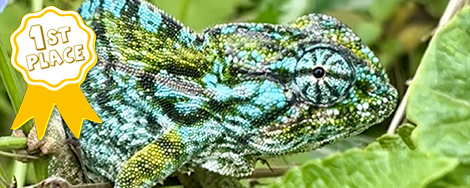Navigation
Install the app
How to install the app on iOS
Follow along with the video below to see how to install our site as a web app on your home screen.
Note: This feature may not be available in some browsers.
More options
You are using an out of date browser. It may not display this or other websites correctly.
You should upgrade or use an alternative browser.
You should upgrade or use an alternative browser.
Home Page
Recent Discussions
- Replies
- 0
- Views
- 37
- Replies
- 0
- Views
- 36
- Replies
- 41
- Views
- 2K
- Replies
- 11
- Views
- 636
Did You Know?
Furcifer oustaleti (Oustalet’s Chameleon) is the longest chameleon species reaching lengths of 27 inches (68cm).
The largest chameleon species by weight is Calumma parsonii (Parson’s Chameleon).
The word Kinyongia is from the Swahili word for chameleons: Kinyonga.
Chameleons have laterally compressed bodies. This enables them to warm up quickly by presenting a larger surface area to the sun. It also helps some chameleon species blend in among the similarly shaped leaves in their environment.
Chameleons do not have external ears or a tympanic membrane, but they do have internal ears as well as degenerated middle ears. They do not hear well but they can detect low frequency sounds.
Chameleon fossils have been found in central Europe and China, indicating they were once much more widespread than they are now.
Pygmy chameleons have bicuspid claws where each claw has two points like a crescent moon.
The word Rieppeleon is named after the scientist Olivier Rieppel.
Trioceros schubotzi can be found at elevations as high as 4500m.
The oldest known chameleon fossil is from the extinct species Chamaeleo caroliquarti. It was found in Europe and is 26 million years old.
We love our sponsors
- Chameleons Only
- Mist King
- Tortoise Supply
- Great Lakes Hornworm
- LLLReptile
- Mulberry Farms
- Chameleon Paradise
- Coastal Silkworms
- Dubia Roaches
- Dragon Strand
- Chamelicious Chameleons
- Full Throttle Feeders
- Gulf Coast Silkworms
- Chromatic Chameleons
- Sticky Tongue Farms
- The Critter Depot
- Mantis Place
- Rebecca Wang Art
- iPardalis
- Rainbow Mealworms
- FramsChams
- Light Your Reptiles
- Neptune the Chameleon
- Tamura Designs
Featured Blog Entries
-
Egg Laying and the Laying Bin
- jannb
- Views: 122K
- Reaction score: 32
- Comments: 25
- General
I free range my chameleons so I really have to pay close attention to when it’s time to lay eggs. I think one of the most important things is to... -
Intro to Bio-Activity
- cyberlocc
- Views: 46K
- Reaction score: 35
- Comments: 23
- General
Introduction to Bio-Activity: As of recent times, a lot of folks have been asking questions, and for guides on Bio-active Enclosures. How to set... -
Individual Baby Cages or Caging during the time of Covid
- JacksJill
- Views: 16K
- Reaction score: 9
- Comments: 8
- General
My first prototype I was planning on using Exo-terra Nano glass cages for my baby cages but the supply chain issues we are all too familiar with...
Trending Topics
-
-
-
-
Please help! Veiled Chameleon has refused food and always in the dark.
- Started by Alex7383
- Replies: 68
-




